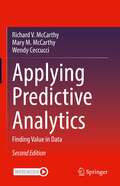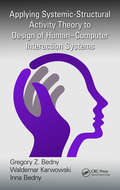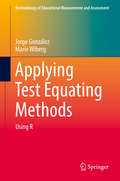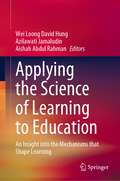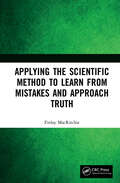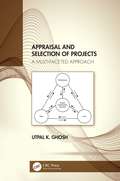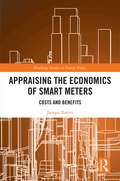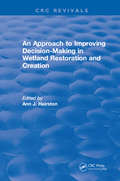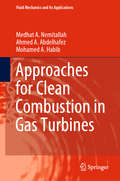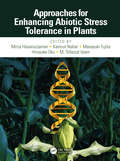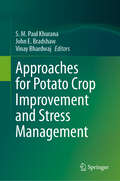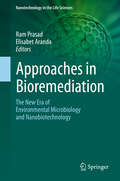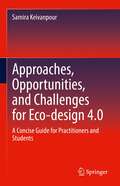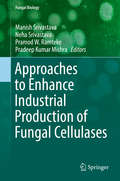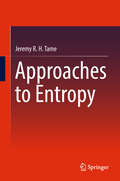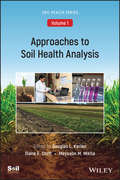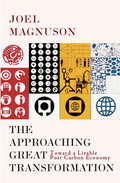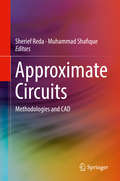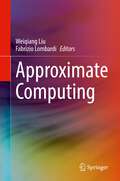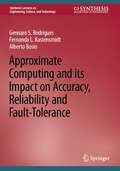- Table View
- List View
Applying Predictive Analytics: Finding Value in Data
by Richard V. McCarthy Mary M. McCarthy Wendy CeccucciThe new edition of this textbook presents a practical, updated approach to predictive analytics for classroom learning. The authors focus on using analytics to solve business problems and compares several different modeling techniques, all explained from examples using the SAS Enterprise Miner software. The authors demystify complex algorithms to show how they can be utilized and explained within the context of enhancing business opportunities. Each chapter includes an opening vignette that provides real-life examples of how business analytics have been used in various aspects of organizations to solve issues or improve their results. A running case provides an example of a how to build and analyze a complex analytics model and utilize it to predict future outcomes. The new edition includes chapters on clusters and associations and text mining to support predictive models. An additional case is also included that can be used with each chapter or as a semester project.
Applying Systemic-Structural Activity Theory to Design of Human-Computer Interaction Systems (Ergonomics Design & Mgmt. Theory & Applications)
by Gregory Z. Bedny Waldemar Karwowski Inna BednyHuman Computer Interaction (HCI) is no longer limited to trained software users. Today people interact with various devices such as mobile phones, tablets, and laptops. How can such interaction be made more user friendly, even when user proficiency levels vary? This book explores methods for assessing the psychological complexity of compute
Applying Test Equating Methods: Using R (Methodology of Educational Measurement and Assessment)
by Marie Wiberg Jorge GonzálezThis book describes how to use test equating methods in practice. The non-commercial software R is used throughout the book to illustrate how to perform different equating methods when scores data are collected under different data collection designs, such as equivalent groups design, single group design, counterbalanced design and non equivalent groups with anchor test design. The R packages equate, kequate and SNSequate, among others, are used to practically illustrate the different methods, while simulated and real data sets illustrate how the methods are conducted with the program R. The book covers traditional equating methods including, mean and linear equating, frequency estimation equating and chain equating, as well as modern equating methods such as kernel equating, local equating and combinations of these. It also offers chapters on observed and true score item response theory equating and discusses recent developments within the equating field. More specifically it covers the issue of including covariates within the equating process, the use of different kernels and ways of selecting bandwidths in kernel equating, and the Bayesian nonparametric estimation of equating functions. It also illustrates how to evaluate equating in practice using simulation and different equating specific measures such as the standard error of equating, percent relative error, different that matters and others.
Applying the Science of Learning to Education: An Insight into the Mechanisms that Shape Learning
by Wei Loong David Hung Azilawati Jamaludin Aishah Abdul RahmanThis book provides an overview of the various 'Science of Learning' (SoL) research projects led by researchers at the National Institute of Education, Nanyang Technological University, Singapore, and international research collaborators. It presents the goals and rationale behind the Science of Learning in Education (SoLE) initiative and examines a spectrum of topics relevant to bolstering our understanding of the science underlying learning. The Science of Learning (SoL) is an advancing field, with proponents extolling its potential impact on educational practice. This book investigates the possible correlations or causal relationships between brain functioning and development, physiology, environment factors, and their impact on learning. It promotes an interdisciplinary approach to understanding biological to behavioural mechanisms of learning that are oriented toward optimizing and maximizing every learner’s potential.
Applying the Scientific Method to Learn from Mistakes and Approach Truth
by Finlay MacRitchieIn its simplest form, the scientific method can be thought of as learning from our mistakes and trying to correct them. True scientists try to think rationally, never adopt dogmatic opinions and are always willing to listen to opposing views. They never claim to know the absolute truth but are relentless in their search for it. In this timely book, the author describes the fundamentals of critical scientific thinking. The book further examines the correct use of the scientific method and how to apply it to current events and scientific topics to obtain honest assessments. Current controversies discussed include climate change and COVID-related lockdowns.Additional Features include: Demonstrates the use of the scientific method to assist with objective analysis of issues Addresses that induction plays a role but the true method for advancing knowledge is hypothesis-deduction Explores current hot topics within the framework of the scientific method Outlines common misunderstandings of the scientific method Applying the Scientific Method to Learn from Mistakes and Approach Truth is approachable enough for the general public and recommended for university and advanced high school science educators and their students.
Applying TQM to Product Design and Development (Quality and Reliability)
by Marvin Moss"Comprehensively covers all phases of the application of Total Quality Management (TQM) to product design and development--from initial concept to customer support--addressing statistical quality control, manufacturing engineering, processes and procedures management, and motivation management. Provides rigorous definitions of the principles of TQM."
Appraisal and Selection of Projects: A Multi-faceted Approach
by Utpal K. GhoshProject appraisal is the process of assessing in a systematic way, the viability of a project at its initial ‘idea’ stage when information is minimal, but the decision, whether to go ahead with the project, is important, and this book deals with the principles and practice of such appraisal process. It covers all the financial and economic aspects, including market and technical analysis, environmental appraisal, life cycle costing and SWOT analysis. This book starts with basis of the subject followed by analysis of the project proposals from different perspectives for ascertaining their viabilities, including a brief discussion on uncertainty and risk analysis, important tools, and techniques. This book covers projects in almost all domains, such as engineering, management, medical science and so forth. Focuses on all possible aspects of project appraisal and selection Emphasizes differences from public and private projects in terms of financial and economic evaluations Provides step-by-step methods of analysis of multiple issues involved in the initial appraisal of projects Includes sections on ‘lessons learned and learning from experience’ illustrating applications of the process and implications Covers feasibility analysis, including both technical aspects and financial evaluation This book is aimed at professionals, graduate students in civil and industrial engineering, business management, project management, project appraisal, including entrepreneurs for their start-up projects. Utpal K. Ghosh is a Chartered Engineer, a Fellow of the Institution of Engineers (India), a Member of the Institution of Civil Engineers (UK) and a Member of the Institution of Structural Engineers (UK).
The Appraisal of Rural Property (2nd edition)
by Appraisal InstituteThis text is a comprehensive reference work that covers all aspects of the valuation of rural properties from both theoretical and practical perspectives. It explores the components of rural property value and the essentials of property inspection, data collection and analysis, and the application of valuation methodology. Specific details relating to dairy farms, livestock ranches, and orchards are included as well as information on government regulations and resources.
Appraising the Economics of Smart Meters: Costs and Benefits (Routledge Studies in Energy Policy)
by Jacopo TorritiThis book focuses on the economics of smart meters and is one of the first to present comprehensive evidence on the impacts, cost-benefits and risks associated with smart metering. Throughout this volume, Jacopo Torriti integrates his findings from institutional cost-benefit analyses and smart metering trials in a range of European countries with key economic and social concepts and policy insights derived from almost ten years of research in this area. He explores the extent to which the benefits of smart meters outweigh the cost, and poses key questions including: which energy savings can be expected from the roll out of smart meters in households? Is Cost-Benefit Analysis an appropriate economic tool for assessing the impacts of smart metering rollouts? Can smart meters play a significant role in research on people’s activities and the timing of energy demand? Torriti concludes by providing a much-needed survey of recent changes and expected future developments in this growing field. This book will be of great interest to students and scholars of energy policy and demand and smart metering infrastructure.
An Approach to Improving Decision-Making in Wetland Restoration and Creation: An Approach To Improving Decision Making In Wetland Restoration And Creation
by Mary E. KentulaAn Approach to Improving Decision-Making in Wetland Restoration and Creation succinctly compares populations of natural and created wetlands to determine whether restored wetlands successfully replace wetlands lost to development or other pressures. The book also presents strategies for mitigation of wetland losses, site selection for wetland restoration projects, and assessment of the level of attainable function for restored wetlands. The book is a significant resource for helping wetland professionals, planners, and ecologists formulate decisions affecting the creation and restoration of wetlands.
Approaches for Clean Combustion in Gas Turbines (Fluid Mechanics and Its Applications #122)
by Medhat A. Nemitallah Mohamed A. Habib Ahmed A. AbdelhafezThis book focuses on the development of novel combustion approaches and burner designs for clean power generation in gas turbines. It shows the reader how to control the release of pollutants to the environment in an effort to reduce global warming. After an introduction to global warming issues and clean power production for gas turbine applications, subsequent chapters address premixed combustion, burner designs for clean power generation, gas turbine performance, and insights on gas turbine operability. Given its scope, the book can be used as a textbook for graduate-level courses on clean combustion, or as a reference book to accompany compact courses for mechanical engineers and young researchers around the world.
Approaches for Enhancing Abiotic Stress Tolerance in Plants
by Mirza Hasanuzzaman Kamrun Nahar Masayuki Fujita Hirosuke Oku Tofazzal IslamPlants are frequently exposed to unfavorable and adverse environmental conditions known as abiotic stressors. These factors can include salinity, drought, heat, cold, flooding, heavy metals, and UV radiation which pose serious threats to the sustainability of crop yields. Since abiotic stresses are major constraints for crop production, finding the approaches to enhance stress tolerance is crucial to increase crop production and increase food security. This book discusses approaches to enhance abiotic stress tolerance in crop plants on a global scale. Plants scientists and breeders will learn how to further mitigate plant responses and develop new crop varieties for the changing climate.
Approaches for Potato Crop Improvement and Stress Management
by John E. Bradshaw S. M. Paul Khurana Vinay BhardwajThis edited book provides an all-inclusive coverage of latest research in crop improvement and stress management in potato crop. It is composed of 17 chapters covering breeding, diseases & pest management with the view to enhancing the total production and quality under the scenario of climate change. The book also explores harvesting, storage, post-harvest management, and processing of potato. The book has special focus on the use of high throughput next generation sequencing (NGS) techniques, modern genomics tools, genome editing techniques such as CRISPR systems that could help the potato breeding programs and, also in development of biotic and abiotic stress resistant varieties. Potato is the world’s third most important food crop after wheat and rice in terms of human consumption. It is the staple crop providing maximum nutrients per unit area, time and money and is the most versatile crop with the highest industrial production potential in India being the second largest potato producing country after China. As a major food crop, the potato has the most important role to play in the United Nations’ Sustainable Development Goals’ 2030 Agenda for zero hunger, achieving food security, improved nutrition, and promote sustainable agriculture. This book is unique in its approach for providing in depth knowledge enabling readers to learn the subject fully on different strategies, new perspectives and fully understanding different topics of diversity, interaction and improvement for stress management in potato. It is a relevant reading material for researchers, students, practitioners and other stakeholders involved in improvement of potato crop.
Approaches in Bioremediation: The New Era of Environmental Microbiology and Nanobiotechnology (Nanotechnology in the Life Sciences)
by Ram Prasad Elisabet ArandaBioremediation refers to the clean‐up of pollution in soil, groundwater, surface water, and air using typically microbiological processes. It uses naturally occurring bacteria and fungi or plants to degrade, transform or detoxify hazardous substances to human health or the environment.For bioremediation to be effective, microorganisms must enzymatically attack the pollutants and convert them to harmless products. As bioremediation can be effective only where environmental conditions permit microbial growth and action, its application often involves the management of ecological factors to allow microbial growth and degradation to continue at a faster rate. Like other technologies, bioremediation has its limitations. Some contaminants, such as chlorinated organic or high aromatic hydrocarbons, are resistant to microbial attack. They are degraded either gradually or not at all, hence, it is not easy to envisage the rates of clean-up for bioremediation implementation.Bioremediation represents a field of great expansion due to the important development of new technologies. Among them, several decades on metagenomics expansion has led to the detection of autochthonous microbiota that plays a key role during transformation. Transcriptomic guides us to know the expression of key genes and proteomics allow the characterization of proteins that conduct specific reactions. In this book we show specific technologies applied in bioremediation of main interest for research in the field, with special attention on fungi, which have been poorly studied microorganisms. Finally, new approaches in the field, such as CRISPR-CAS9, are also discussed. Lastly, it introduces management strategies, such as bioremediation application for managing affected environment and bioremediation approaches. Examples of successful bioremediation applications are illustrated in radionuclide entrapment and retardation, soil stabilization and remediation of polycyclic aromatic hydrocarbons, phenols, plastics or fluorinated compounds. Other emerging bioremediation methods include electro bioremediation, microbe-availed phytoremediation, genetic recombinant technologies in enhancing plants in accumulation of inorganic metals, and metalloids as well as degradation of organic pollutants, protein-metabolic engineering to increase bioremediation efficiency, including nanotechnology applications are also discussed.
Approaches, Opportunities, and Challenges for Eco-design 4.0: A Concise Guide for Practitioners and Students
by Samira KeivanpourThis book addresses the implications of the Industry 4.0 paradigm in design for the environment. We examine the opportunities for, and challenges of, the implications of cyber-physical systems, big data analytics, Internet of things, additive manufacturing, and simulation in a range of areas in an eco-design context. These include selecting low impact materials, choosing manufacturing processes with environmental considerations, end of life strategies, applying design approaches for disassembly, integrating economic and social components into environmental studies, and stakeholder’s involvement. This volume takes a step toward this journey to explore how the three pillars of technology, sustainability, and evolving consumers could shape the future of the product’s design.
Approaches to Enhance Industrial Production of Fungal Cellulases (Fungal Biology)
by Manish Srivastava Neha Srivastava Pramod W. Ramteke Pradeep Kumar MishraCellulase is a key enzyme of industrial interest and plays a crucial role in the hydrolysis of cellulose, a prime component of plant cell walls. Cellulase covers a broad area in the global market of industrially important enzymes and it is considered as the third largest industrial enzyme globally. Additionally, cellulase contributes about 20% of the total enzyme market globally because of its massive demand in various industries such as in biofuel production, pulp, paper, textile, food, and beverages, as well as in detergent industries. Among these, the demand of cellulase may become frequently selected in the commercial production of biofuels in the future and thus will further increase demand of cellulase in the biofuel industry. Because biofuel production is still not realized in a cost-effective, practical implementation due to its high cost (the higher cost of biofuels is due to higher production costs of enzymes), there is a need to introduce these types of approaches, which will help to lower the cost of enzyme production for developing overall economic biofuel production.
Approaches to Entropy
by Jeremy R. TameThis is a book about thermodynamics, not history, but it adopts a semi-historical approach in order to highlight different approaches to entropy. The book does not follow a rigid temporal order of events, nor it is meant to be comprehensive. It includes solved examples for a solid understanding. The division into chapters under the names of key players in the development of the field is not intended to separate these individual contributions entirely, but to highlight their different approaches to entropy. This structure helps to provide a different view-point from other text-books on entropy.
Approaches to Road Safety: Evolution, Challenges, and Emerging Technologies
by Peter SweatmanRoad transport is on a constant course to maintain and improve driving safety in what is a complex process involving multiple forms of risk. It is time for embracing system technologies that give more meaning to the philosophical phrase "safe system" and Approaches to Road Safety: Evolution, Challenges, and Emerging Technologies makes the case for the adoption of safer systems in road transport industries through the embracing of technological paradigms, system attributes and more clearly articulated values. This book offers an account of the professional road safety enterprise in action in the United States, Australia and elsewhere, covering the contributions of Haddon in the 1960s, the creation of NHTSA, the development of the science of human factors, the enduring philosophy of countermeasures to motor vehicle crashes, motor vehicle safety regulations, occupant restraint and protection, collision avoidance, road and traffic design, driver assistance systems, pre-crash scenarios and vulnerable road users. It addresses the harm caused by roadway collisions, including the strategies of Vision Zero and the safe system. It places the enterprise of road safety within the greater system of road vehicle transportation. It also covers ethical preoccupations besides safety, including the rise of sustainability and its operational challenges, including uneven professionalism. Automation and the rise of driverless vehicles are discussed with these being described as a useful long-term change-agent in transportation systems. The important paradigm of connected vehicles and infrastructure is also described, along with the under-utilized science of human factors. The reader is exposed to a nuanced look at the world of road transport safety through its beginnings to the modern age of automation, allowing them to have a contextualized view of the subject area.Offering valuable insights, this book will appeal to professionals in the fields of safety, human factors, the automotive industry, traffic control, vehicle standards and regulations, transportation systems and road safety policy.
Approaches to Soil Health Analysis (ASA, CSSA, and SSSA Books #190)
by Douglas L. Karlen Diane E. Stott Maysoon M. MikhaApproaches to Soil Health Analysis A concise survey of soil health analysis and its various techniques and applications The maintenance of healthy soil resources provides the foundation for an array of global efforts and initiatives that affect humanity. Whether they are working to combat food shortages, conserve our ecosystems, or mitigate the impact of climate change, researchers and agriculturalists the world over must be able to correctly examine and understand the complex nature of this essential, fragile resource. These new volumes have been designed to meet this need, addressing the many dimensions of soil health analysis in chapters that are concise, accessible and applicable to the tasks at hand. Soil Health, Volume One: Approaches to Soil Health Analysis provides a well-rounded overview of the various methods and strategies available to analysists, and covers topics including: The history of soil health and its studyChallenges and opportunities facing analysistsMeta-data and its assessmentApplications to forestry and urban land reclamationFuture soil health monitoring and evaluation approaches Offering a far-reaching survey of this increasingly interdisciplinary field, this volume will be of great interest to all those working in agriculture, private sector businesses, non-governmental organizations (NGOs), academic-, state-, and federal-research projects, as well as state and federal soil conservation, water quality and other environmental programs.
The Approaching Great Transformation
by Joel Magnuson Helena Norberg-HodgeHow should we act and think economically in the world as the era of cheap oil comes to an end? The Approaching Great Transformation begins to answer this massive question, focusing on the people and communities already at work on the transition: energy descent pioneers in the UK and the US educating their communities about the road ahead, small enterprises defying traditional "profit" in favor of permanence and sustainability, and cities preparing for a post carbon future.Highlighting the work of thinkers like John Ruskin and E. F. Schumacher, Magnuson here builds on his previous book, Mindful Economics. is already being done. The Approaching Great Transformation extends the ideas put forth in Magnuson's previous book,Mindful Economics, and features a foreword by Helena Noberg-Hodge.
Approximate Arithmetic Circuit Architectures for FPGA-based Systems
by Salim Ullah Akash KumarThis book presents various novel architectures for FPGA-optimized accurate and approximate operators, their detailed accuracy and performance analysis, various techniques to model the behavior of approximate operators, and thorough application-level analysis to evaluate the impact of approximations on the final output quality and performance metrics. As multiplication is one of the most commonly used and computationally expensive operations in various error-resilient applications such as digital signal and image processing and machine learning algorithms, this book particularly focuses on this operation. The book starts by elaborating on the various sources of error resilience and opportunities available for approximations on various layers of the computation stack. It then provides a detailed description of the state-of-the-art approximate computing-related works and highlights their limitations.
Approximate Circuits: Methodologies and CAD
by Sherief Reda Muhammad ShafiqueThis book provides readers with a comprehensive, state-of-the-art overview of approximate computing, enabling the design trade-off of accuracy for achieving better power/performance efficiencies, through the simplification of underlying computing resources. The authors describe in detail various efforts to generate approximate hardware systems, while still providing an overview of support techniques at other computing layers. The book is organized by techniques for various hardware components, from basic building blocks to general circuits and systems.
Approximate Computing
by Weiqiang Liu Fabrizio LombardiThis book explores the technological developments at various levels of abstraction, of the new paradigm of approximate computing. The authors describe in a single-source the state-of-the-art, covering the entire spectrum of research activities in approximate computing, bridging device, circuit, architecture, and system levels. Content includes tutorials, reviews and surveys of current theoretical/experimental results, design methodologies and applications developed in approximate computing for a wide scope of readership and specialists.Serves as a single-source reference to state-of-the-art of approximate computing;Covers broad range of topics, from circuits to applications;Includes contributions by leading researchers, from academia and industry.
Approximate Computing and its Impact on Accuracy, Reliability and Fault-Tolerance (Synthesis Lectures on Engineering, Science, and Technology)
by Gennaro S. Rodrigues Fernanda L. Kastensmidt Alberto BosioThis book introduces the concept of approximate computing for software and hardware designs and its impact on the reliability of embedded systems. It presents approximate computing methods and proposes approximate fault tolerance techniques applied to programmable hardware and embedded software to provide reliability at low computational costs. The book also presents fault tolerance techniques based on approximate computing, thus presenting how approximate computing can be applied to safety-critical systems.
Approximate Iterative Algorithms
by Anthony Louis AlmudevarIterative algorithms often rely on approximate evaluation techniques, which may include statistical estimation, computer simulation or functional approximation. This volume presents methods for the study of approximate iterative algorithms, providing tools for the derivation of error bounds and convergence rates, and for the optimal design of such
